Introduction
Bulbophyllum Thouars is one of the largest genera in Orchidaceae, comprising around 2147 accepted species (POWO 2023) distributed in the tropical and subtropical regions of the world (Chase et al. 2015, Gyeltshen et al. 2020, POWO 2023, Pridgeon et al. 2014, Vermeulen et al. 2014). In Bhutan, 62 species have been documented (Dalström et al. 2017, Gurung 2006, Gyeltshen et al. 2020, 2021, Pearce & Cribb 2002, Rabgay et al. 2021, Zangpo et al. 2021). However, the diversity of this genus in the country is poorly surveyed and documented compared to the neighboring countries. This is particularly true for miniature orchids that grow on tall trees (Averyanov et al. 2019) and in thick grassland, which are easily overlooked and rarely collected by researchers. Moreover, the taxonomic complexity of Bulbophyllum, with its large number of species, minuscule morphological differences, and wide distribution range, requires thorough examination and in-depth studies for accurate identification and documentation.
In 2006, Prof. Dhan Bahadur Gurung collected an interesting species of Bulbophyllum from the broadleaved forest in Punakha district while documenting the orchids of Bhutan. However, it remained unidentified in his book ‘An Illustrated Guide to the Orchids of Bhutan’ (Gurung 2006). During botanical exploration in the different parts of the district in 2022, the first two authors (PG and KR) spotted the same species growing on the main tree trunk of dead-standing Alnus nepalensis D.Don and the rotten stump of Juglans regia L. Furthermore, during a survey in Menchuna in 2020, PG observed and collected another interesting Bulbophyllum species similar to Bulbophyllum retusiusculum Rchb.f. growing on the main trunk and branches of Alnus nepalensis, Torricellia tiliifolia DC., and Symplocos ramosissima Wall. ex G.Don. After a critical examination of the specimens and consultation of available literature and related species described from the Eastern Himalayan and Southeast Asian region, we identified both the species as new to science, one belonging to the section Biseta J.J.Verm. and the other to the section Brachyantha Rchb.f. (Averyanov et al. 2018, Chen & Vermeulen 2009, Lucksom 2007, Nguyen et al. 2022, Pearce & Cribb 2002, Pridgeon et al. 2014, Seidenfaden 1973, 1979, Seidenfaden & Arora 1982, Tsi & Chen 1994, Vermeulen et al. 2014).
According to Vermeulen et al. (2014), members of Bulbophyllum sect. Biseta are characterized by oneleaved pseudobulbs along a creeping rhizome, a contracted or elongated racemose inflorescence that arises from the base of the pseudobulb, a pedicel with the basal node positioned above the attachment of the floral bract, a free dorsal sepal, lateral sepals that are 1 to 1.6 times longer than the dorsal sepal, 5-veined, with midvein abaxially keeled, with the apices thickened, globular to ellipsoid to almost cylindrical. The labellum is undivided, without auricles and the column foot often has lateral wings near the apex. Stellidia ca. ½ the length of the column, and the upper margin with or without a tooth, while the lower margin has a tooth. Members of Bulbophyllum sect. Brachyanta are also characterized by several morphological features that distinguish them from other species. They show oneleaved pseudobulbs along a creeping rhizome, a subumbellate inflorescence that arises from the base of the pseudobulb, and the lateral sepals that are 2 to 6 times longer than median sepal. The lateral sepals are twisted at the base with the upper margin turned inward and adnate to each other. The lip simple and connate to the column foot apex, and the column is simple or winged with or without stelidia at the apex.
Materials and methods
Morphological comparisons and assessments were performed using specimens from herbaria: PE, E, K, and THIM, as well as illustrations and taxonomic literature. Living floral parts and vegetative structures of the specimens were photographed in situ with a Nikon D3400 camera, and 18-55 mm f/3.5-5.6 lens. Microscopic structures were photographed with a Z-Stack microscope at the National Biodiversity Centre. The colored plates were prepared and edited in Adobe Photoshop software. Measurements and descriptions were based on the freshly collected material, and the collected specimens were deposited at the National herbarium THIM. In addition, living plants were collected and transplanted in the Royal Botanical Garden at Serbithang in Thimphu, Bhutan.
Taxonomic treatment
Bulbophyllum gurungianum P.Gyeltshen, K.Rabgay & Kumar, sp. nov. (Fig. 1-3).
TYPE: Bhutan. Punakha District: Rimchu, 20 October 2022, P.Gyeltshen & K.Rabgay 69 (holotype THIM; isotypes: THIM).
Diagnosis: Bulbophyllum gurungianum shows morphological similarities with B. brevispicatum Z.H.Tsi & S.C.Chen and B. sonii Aver. & Duy in terms of habit and general floral morphology. However, B. gurungianum can be differentiated from B. brevispicatum based on the narrowly ovoid to ovoid pseudobulbs placed distantly (3-7 cm apart), shorter (13-16 × 1-2 cm) oblong to broadly oblong leaves, shorter peduncle (up to 1 cm long), sepals with sparse hairs on the outer surface, oblong petals with ciliate margin and labellum lacking keels in the former versus subcylindric pseudobulbs that are closely (2 cm apart) placed on the rhizome, longer (17 × 2.8 cm) leaves, longer (2 cm long) peduncle, sepals with dense papillose hairs, petals ovate with irregularly denticulate margin and labellum glabrous with 2 keels in latter. On the other hand, B. sonii has dense papillose hairs on the sepals, petals are ovate-oblong with erose to ciliate margin, and labellum glabrous without any keels (Table 1).
Plant epiphytic with creeping rhizomes and spreading roots. Rhizome terete, 1.4-1.8 mm diam., brown, sections between two pseudobulbs 3-7 cm long, arising from the basal node of the pseudobulb; rhizome scales thick, weathering to woolly fibers, persistent. Pseudobulbs 1-leaved, narrowly ovoid to ovoid, 1-3 × 0.6-1.5 cm, green to yellowish green, with numerous light green to almost white terete roots densely clustering at base; young pseudobulbs smooth, with partially disintegrated papyraceous or membranous sheaths, longitudinally ridged when mature. Leaf subsessile; petiole narrowing into short conduplicate petiole-like base 3.5-4 mm long; blade oblong, narrowly oblanceolate, 13-16 × 1-2 cm, leathery, apex acute or shortly acuminate, adaxially dark green, abaxially light green with a prominent dark green median vein. Inflorescences pendent, short dense-flowered raceme, 7-9 flowered; peduncle stout, slightly arched, ca. 1 cm long, green, glabrous, with 2-4 bracts, young light green and turning into brown with maturity, spirally arranged flowers. Floral bracts lanceolate, 4.5-5.0 × 1-2 mm, concave, light green or almost white, coriaceous, glabrous. Pedicel and ovary 1.8-2.1 mm long, greenish yellow to pale brown-purple, ovary distinctly broader than pedicel, longitudinally grooved. Flowers non-resupinate, not widely opening, sepals and petals purple, labellum pale yellowish with purple tint on the disc; sepals concave, apex acute or narrowly acute; petals flat, abaxially with sparse short and maroon papillous hairs. Dorsal sepal ovate, 4.8-5.0 × 2.3-2.6 mm, with recurved acute apex, shortly setose-ciliated margin towards the apex, 3-nerved. Lateral sepals obliquely ovate, 5-6 × 2.8-3.0 mm (when flattened), connate along lower edges completely or partly free at base and apex, 3-nerved. Petals oblong, 2.8-3.0 × 1.0-1.5 mm, rounded to obtuse apex, margin ciliated, with 1 prominent median vein. Labellum ovate 2.5-3.0 × 1.8-2.1 mm, fleshy, recurved and slightly grooved near the base, simple, sparsely verruculose in apical half adaxially, apex rounded to obtuse, with short setose hairs, side lobes absent. Column terete, 2.8-3.0× 1-2 mm, white, with distinct down and forward di-rected foot ca. 1.5 mm long. Stelidia triangular, 0.5-1.0 mm long, pointing forward, exceeding operculum; operculum oblong, ca. 1.0 × 0.5 mm, yellow, surface densely verruculose, apex obtuse. Pollinia 4, ovoid, ca. 0.5 mm long, yellow. Fruits unknown.
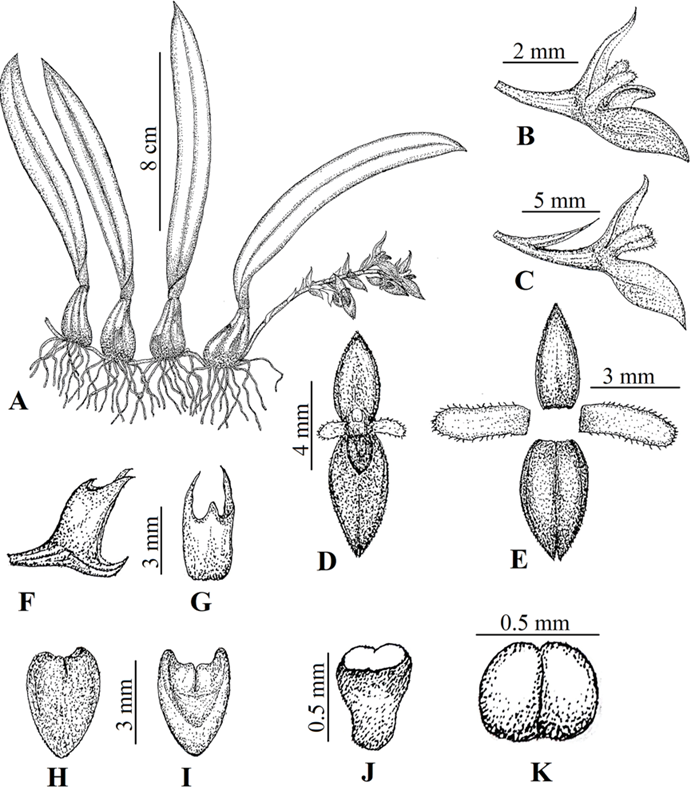
Drawn from holotype by Kezang Tobgay, edited by Phub Gyeltshen.
Figure 1 Bulbophyllum gurungianum P.Gyeltshen, K.Rabgay & Kumar.
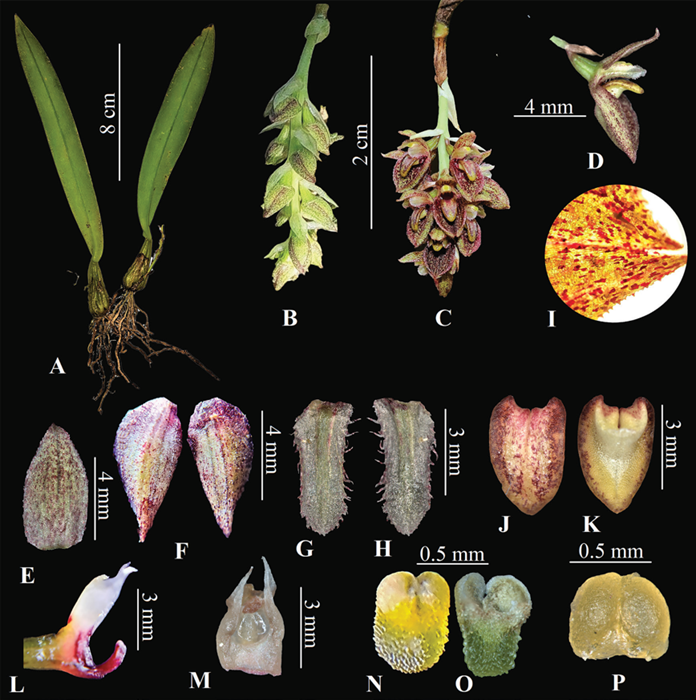
Photographs by Phub Gyeltshen (A, B, D-P) and Kinley Rabgay (C).
Illustration assembled by Phub Gyeltshen.
Figure 2 Bulbophyllum gurungianum P.Gyeltshen, K.Rabgay & Kumar.
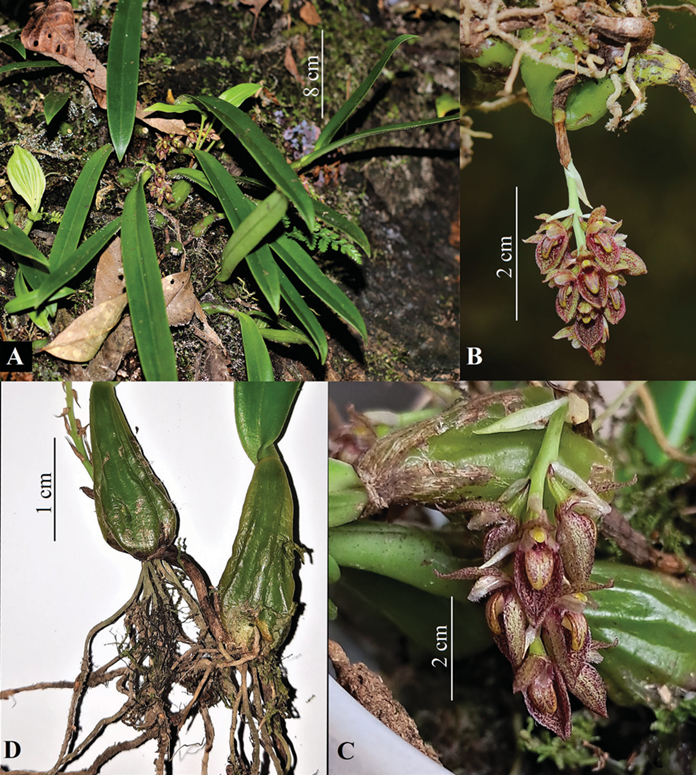
Photographs by Kinley Rabgay (A-B) and Phub Gyeltshen (D-C).
Illustration assembled by Phub Gyeltshen.
Figure 3 Bulbophyllum gurungianum P.Gyeltshen, K.Rabgay & Kumar.
Table 1 Morphological comparison of Bulbophyllum gurungianum and its closely allied species.
| Characters | B. brevispicatum | B. gurungianum | B. sonii |
|---|---|---|---|
| Pseudobulb | subcylindric, 3-3.5 cm tall, distant at 2 cm on rhizome | narrowly ovoid to ovoid, 1-3 cm tall, distant at 3-7 cm on rhizome | narrowly ovoid to ovoid, 0.8-2 × 0.4-1.0 cm, distant at 0.5-2.2 cm |
| Leaves | oblong, 17 × 2.8 cm | oblong broadly oblanceolate, 13-16 × 1-2 cm | oblong broadly lanceolate, 8-13 × 0.8-1.8 cm |
| Inflorescence | peduncle, ca. 2 cm long, 6-7 flowered | peduncle ca. 1 cm long, 7-9 flowered | peduncle, 0.8-2.0 cm long, densely flowered (> 20) |
| Sepals | dense papillose hairs | short sparse and maroon papillose hairs | white dense papillose hairs |
| Petals | ovate, margin irregularly denticulate | oblong, margin ciliated | oblong ovate, margin eroseciliated |
| Labellum | glabrous, with 2 cornute keels on both basal sides | short papillose hairs, keels absent | glabrous, keels lacking |
Etymology: The species is named in honor of Prof. Dhan Bahadur Gurung, who first observed the orchid and for his immense contribution to orchid taxonomy in Bhutan.
Phenology: Flowering in October and November and fruiting from November to December in situ.
Habitat and ecology: In Bhutan, the orchid grows epiphytically on the main tree trunk of Alnus nepalensis, Castanopsis tribuloides (Sm.) A.DC., and the rotten stump of Juglans regia of the warm broadleaved forest at around 1400-2000 m in elevation. The associated plants are Goodyera vittata (Lindl.) Benth. ex Hook.f. and Ficus sp.
Distribution: Bhutan (Punakha, Rimchu, Type) (Fig. 7).
Conservation status: Bulbophyllum gurungianum is known from three sites, with around 60 mature individuals. Based on GeoCat (Moat, 2007), the Extent of Occurrence (EOO) and Area of Occupancy (AOO) of the species is estimated as 32.9 km2 and 16 km2, respectively. Since the species grows on the dead tree trunk and rotten stumps, the collapse of the dead tree and further rotting of the stump is likely to threaten the existing population. However, this is a natural process. Although similar habitats are available, the new species was not encountered in adjoining areas. Therefore, based on available information, currently, the species can be assessed as Data Deficient (DD) until further studies have been conducted exclusively (IUCN 2022).
Notes: Bulbophyllum sonii, which is used for comparison with B. gurungianum, belongs to the B. sect. Biseta, as it shows a simple lip without auricles. Interestingly, B. sonii reported from Tibet Autonomous region of China by Lei et al. (2022) deserved to be a distinct species, and it should be B. gurungianum described in this study because inflorescence is raceme, with less dense flowers, 8-12 flowered (vs. more dense, ca.>20 flowers per inflorescence in B. sonii), petals oblong (vs. oblong-ovate), margin ciliate (vs. finely erose-ciliate).
Bulbophyllum punakhaense P.Gyeltshen, K.Rabgay & Kumar, sp.nov. (Fig. 4-6).
TYPE: Bhutan. Punakha District: Menchuna, 15 October 2022, P.Gyeltshen & K.Rabgay 070 (holotype THIM; isotypes: THIM).
Diagnosis: Bulbophyllum punakhaense shares morphological similarities with B. farreri (W.W.Sm.) Seidenf., B. thaiorum J.J.Sm., and B. mamillatum Vuong, Aver. & V.S.Dang in having coarsely papillose lateral sepals but differs in having laxly placed and longer (2.5-4.5 cm) pseudobulbs, dorsal sepal ovate-oblong, obtuse and densely papillose on the outer surface towards the base and margin shortly papillose towards the apex, lateral sepals together forming ca. elliptic structure (widest point approximately halfway along its length), petals oblong, obtuse and shortly papillose towards the apex, labellum shortly papillose on margin and apex (Table 2).
Plant epiphytic with creeping rhizomes and spreading roots. Rhizome 0.4-1.8 mm diam., brown, arising from the base of the pseudobulb, pseudobulbs placed at 1.5-6 cm long intervals, rhizome covered with thick scales that weather to woolly fibers, persistent. Pseudobulbs 1-leaved, narrowly ovoid to ovoid, 2.5-4.5 × 1.0-1.5 cm, green to yellowish-green with numerous light-green to almost white cylindrical roots densely clustering at the base, covered with partially disintegrated membranous sheaths, longitudinally ridged, with many numerous white roots densely clustering at base. Leaf 1, oblong-lanceolate, 6-16 × 1.0-2.3 cm, apex acute or shortly acuminate, coriaceous, adaxially dark green, abaxially light green with prominent dark green median vein, margin entire, apex rounded, slightly retuse. Petiole short conduplicate, 3.5-5.0 mm long. Inflorescence a subumbellate raceme, 5-12-flowered, arising from the base of the pseudobulb; peduncle horizontal or pendulous, 10-18 cm long, with 3 to 4 brown tubular overlapping bracts at base and 1-3 distant bracts in middle part, green, glabrous, young bracts are light green when young and turning brown with maturity. Floral bracts narrowly lanceolate, 5-8 × 1-2 mm, concave, white, herbaceous, glabrous, apex acuminate. Pedicel and ovary 0.8-1.0 cm long, pedicel pink, slender, slightly curved, ovary golden green with maroon stripes, thicker, glabrous, longitudinally grooved. Flowers resupinate, not widely open, lateral sepals maroon; median sepal, petals and labellum white with purple patches. Dorsal sepal oblong-ovate, 3.8-4.1 × 2-3 mm, apex obtuse, with short papillose margin abaxially densely papillose on basal concave part, sparsely papillose towards apex, 3-nerved. Lateral sepals narrowly lanceolate, 1.5-3.2 × 0.3-0.4 cm, obtuse, twisted at base, upper margin incurved and connate along the margin, free at lower margin, adaxially glabrous, abaxially densely papillose at base, sparsely papillose above base. Petals oblong-lanceolate, 3-4 × 2-3 mm, obtuse, slightly convex, adaxial surface glabrous, slightly oblique sparsely papillose on abaxial surface apex obtuse, shortly ciliate, with 1 prominent median vein. Labellum simple, narrowly ovate in outline, 3 × 1.5 mm, recurved, with rounded apex, with short papillate hairs on margin and apex, base with transverse callus and small appendage joining to column foot. Column broadly ovoid, ca. 1.5 mm tall, maroon, with forwarded and strongly incurved foot ca. 3 mm long, strongly incurved. Stelidia broadly subulate, ca. 0.5 mm long, sometimes with a small branch near the apex; operculum helmet-shaped, ca. 1 mm tall, maroon; pollinia 2, flat, ovoid, 0.5 mm long, yellow. Capsule clavate, 2 × 0.5 cm, glabrous, longitudinally grooved.
Phenology: Flowering in situ from October to November and fruiting from November to December.
Etymology: The specific epithet of the new species refers to the type locality i.e., Punakha in Bhutan.
Habitat and ecology: In Bhutan, it is epiphytic on the primary and secondary branches of Alnus nepalensis, Juglans regia, Symplocos ramosissima, Torricellia tiliifolia, and Quercus griffithii Hook.f. & Thomson ex Miq., of the cool broadleaved forest at an elevation ranging from 2000-2700 m. The associated plants are Pholidota protractaHook.f., Dendrobium longicornu Lindl., and Hedera nepalensis K.Koch.
Distribution: Bhutan (Punakha, Menchuna, Type) and Lhuentse (Fig. 7).
Conservation status: Bulbophyllum punakhaense is only known from four sites in Punakha and one site in Lhuentse Districts. The total population is estimated to be around 200 matured individuals, and according to the GeoCAT (Moat 2007), the Extent of Occurrence (EOO) and Area of Occupancy (AOO) is estimated as 2222.5 km2 and 24 km2, respectively. It is expected that this species may occur in intermediate areas and similar habitats in other districts of the country, but so far, no more populations have been observed. Some subpopulations are located within road buffer and at the periphery of human settlement; an extension of the road and anthropogenic activities may cause habitat degradation and population decline in the future. Based on current information, this species can be assessed as a Data Deficient (DD) until further studies have been conducted exclusively (IUCN 2022).
Notes: Bulbophyllum punakhaense is also similar to B. tigridum Hance, but it differs in having the lateral sepals elliptic-lanceolate, abaxially densely papillose (vs. lanceolate or linear, abaxially glabrous).
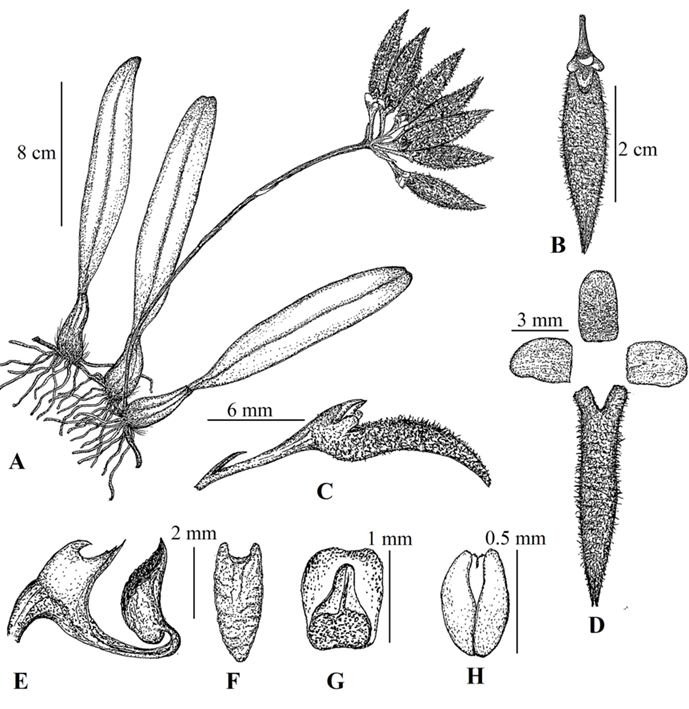
Drawn from holotype by Kezang Tobgay, edited by Phub Gyeltshen.
Figure 4 Bulbophyllum punakhaense P.Gyeltshen, K.Rabgay & Kumar.
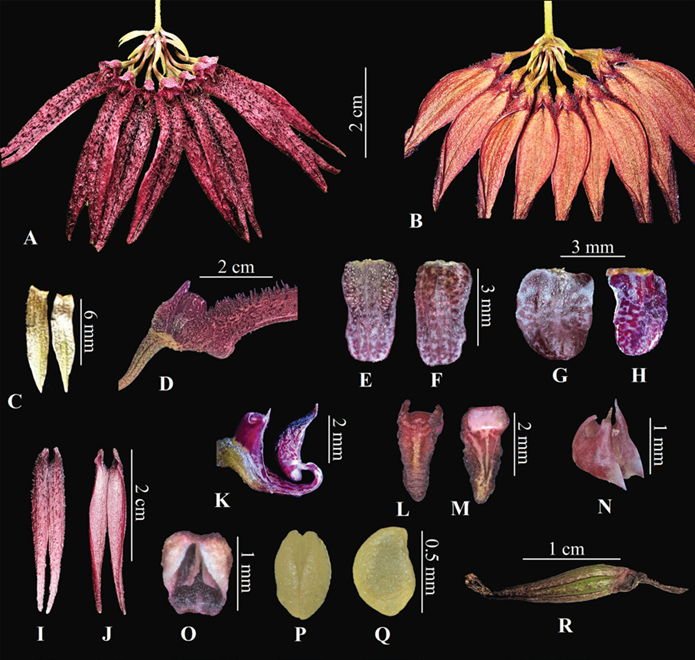
Photographs by Kinley Rabgay (A), Phuentsho (B) and Phub Gyeltshen (C-R).
Illustration assembled by Phub Gyeltshen.
Figure 5 Bulbophyllum punakhaense P.Gyeltshen, K.Rabgay & Kumar.
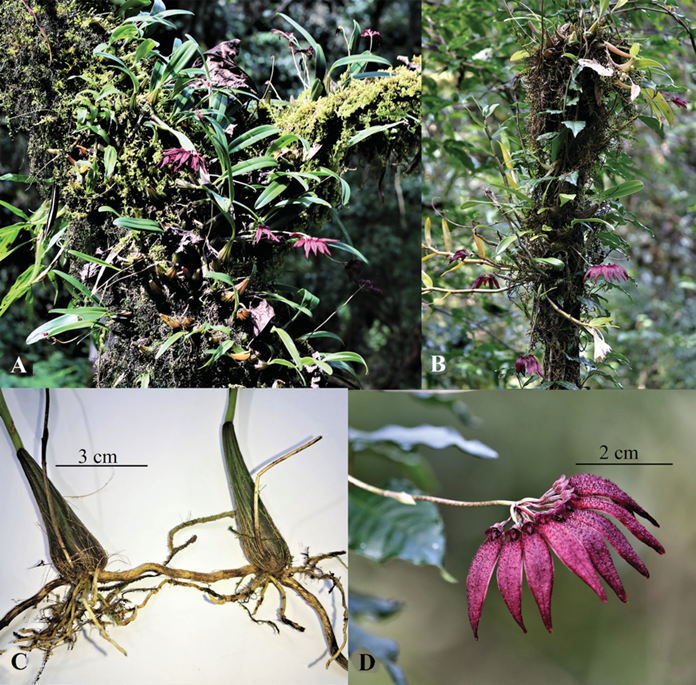
Photos taken Phub Gyeltshen (A & D) and Phuentsho (B-C).
Illustration assembled by Phub Gyeltshen.
Figure 6 Bulbophyllum punakhaense P.Gyeltshen, K.Rabgay & Kumar.
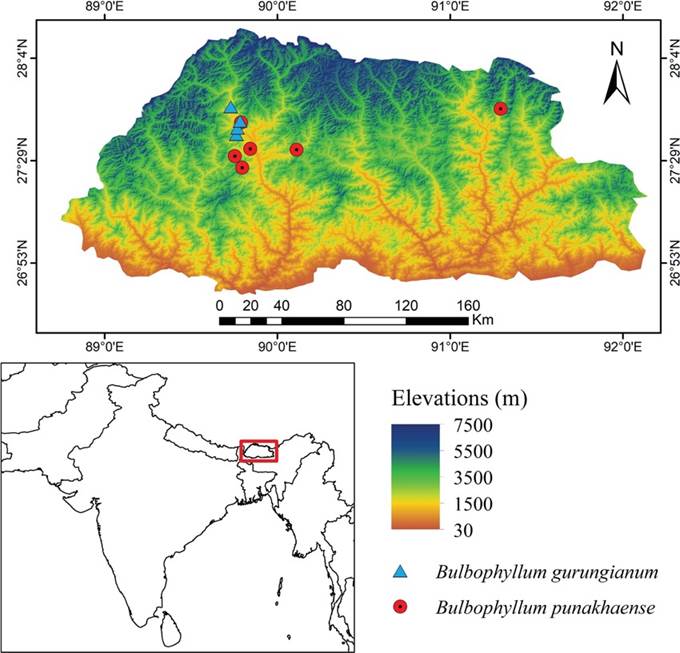
Illustration by Phub Gyeltshen.
Figure 7 Distribution map of Bulbophyllum gurungianum and Bulbophyllum punakhaense in Bhutan.
Table 2 Morphological comparison of Bulbophyllum punakhaense and its closely allied species.
| Characters | B. farreri | B. mamillatum | B. punakhaense | B. thaiorum |
|---|---|---|---|---|
| Pseudobulb | clustered, ovoid-globose, 0.9-1.2 cm tall | close, narrowly ovoid to ovoid, erect, 1.6-2 cm tall | distantly placed, narrowly ovoid to ovoid, 2.5-4.5 cm tall | clustered, narrowly ovoid, ca.2 cm tall |
| Leaves | oblong, 2-7 × 0.8-2.2 cm | narrowly oblong, 7.5-8 × 0.7-0.8 cm | oblong-lanceolate, 6-16 × 1.0-2.3 cm | narrowly oblong, ca. 4 × 0.7-0.8 cm |
| Peduncle length | ca. 7 cm | 11.5-12 cm | 10-18 cm long | ca. 5 cm |
| Petals | obliquely elliptic, margin entire | narrowly ovate, margin entire | oblong, shortly papillose margins towards apex | broadly oblong or elliptic-oblong, margin entire |
| Labellum | glabrous | finely hairy along margin and deeply keeled longitudinally with raised sides | shortly papillose hairs on margin and apex | glabrous |












 uBio
uBio 


